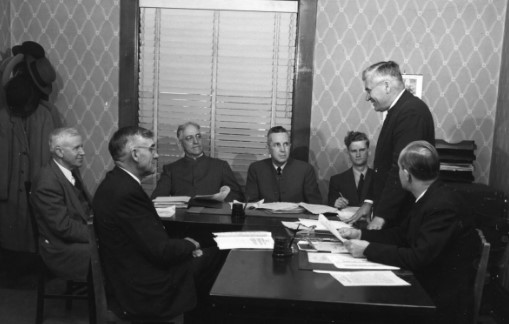Imagine a world where your team and your board of directors work together perfectly.
Your CEO and your board chair—good chums in and out of the office—agree on just about everything, right down to their lunch meeting catering preferences. In those rare moments when they don’t agree, the two engage in respectful, productive debate before arriving at a consensus that immediately benefits the entire organization and its mission.
The CEO welcomes the input and mentorship of your wise, caring board members. At the same time, the board is careful not to step on your team’s toes, recognizing and affirming the healthy boundaries between governance and management.
The feelings shared between upper management, staff, and the board are so gosh-darn fuzzy that you can’t wait for those all-too-rare quarterly meetings where you all crowd around a conference table and think about how to make the world a better place. For days afterwards, the break room coffee tastes as full-bodied and rich as fine European chocolate; the loose HVAC fan in the ceiling sounds like a sublime jazz solo; and the sun-baked dumpster behind your office complex smells like fresh-cut petunias...
Show of hands—how many of you spend your days working in a place like this?

Obviously, for most organizations, board relations are a bit more complicated.
Like the rest of us, board members are, first and foremost, people—and people have off-days. They may become too involved in your day-to-day operations, causing roadblocks and preventing you from reaching your goals. Alternatively, they may be too distant, leaving you to struggle through problems on your own. Small wonder that even the best board/management relationships will involve occasional tension, frustration, and angst.
In spite of all this, for many organizations there are definite benefits to having a board of directors, including strategic guidance, larger networks, and improved credibility. A good relationship with your board is worth fighting for—and how you communicate with board members plays a big part in determining what your relationship will be like.
Whether you’re a for-profit business or a nonprofit entity, board relations are going to have an impact on how you work. Make that impact a good one by following these three tips to keep your board members happy, helpful, and informed.
1. Use Your Storytelling Chops
When you’re getting ready to present a new idea to your board members, it can be helpful to remember that they, just like your customers or donors, are an audience. And the best way to reach an audience is to know its members inside and out, and present your case in the way that makes the most sense to them.
As we’ve talked about before, one of the keys to effective brand storytelling is recognizing that the audience, not the brand, is the Hero of the story you’re trying to tell. The audience member’s struggle to meet their own goals—not the brand’s goals—is the engine of the plot that drives that story to its resolution, i.e. a transformative experience for the audience and an ongoing relationship with your brand.
In the same way, when talking with your board members, it can be helpful to frame your organizational needs in terms of their personal goals. Ask yourself: what do these people hope to gain by being part of the board? What story are they trying to live out, and how can you make it clear that supporting your strategy, budget, marketing campaign, etc. is the best way to give that story a happy ending?
The more specific you can get with this, the better. Wherever possible, get to know the directors as individuals with lives of their own, outside the boardroom. What, specifically, makes each of them interested in your organization? Do they want to be part of a disruptive business that changes the face of an industry? Keep the company on a course of steady growth? Gain prestige or a sense of personal satisfaction by helping your nonprofit fix the world?
Find out, and tailor your message so that it functions as a clear step on the personal Hero’s Journey of each board member.
2. Nail Down Your Strategy—Together
Nothing gets people united around a common goal like defining that goal as a group. But the thought of letting others in on the strategic planning process—particularly when they have power over things like hiring and compensation—can be understandably spooky.
Ultimately, though, getting board members’ input on strategic direction is better for the long-term health of the organization than trying to box them out. Remember that, for the sake of communication, it’s useful to help board members feel like the Heroes of their own stories, who can best achieve their particular goals by helping you reach yours. And it’s hard to feel like a Hero if you’re prevented from sharing what you know and making a difference!
Inviting the board to share its thoughts early in the strategy-development process helps to establish the trust that keeps board relations smooth down the road. As the Harvard Business Review puts it: “involve the board early in deciding on the right, big-picture, strategic direction for the company [...] In this way, the CEO and her team can gain valuable board perspective that will strengthen all the choices that are developed and obtain early board buy-in for both the options and the ultimate strategic plan that’s chosen.”
To put it another way, giving the board a chance to flex its strategic muscles early in the planning process will give you the seasoned outside perspective that only a good board can provide—and head off interference from a frustrated board later on.
The board is going to exercise its power sooner or later. Welcome that input at the right time with an invigorating strategy workshop, and you’ll gain the value of board involvement while minimizing potential disruptions to your organization’s plans.
3. Communicate Frequently and Personally
With management, staff, and board in agreement on a strategic direction, the vital work of ongoing communication begins. At a minimum, the board should receive regular, official updates on your team’s progress towards its strategic goals, such as monthly or quarterly reports. This kind of reliable communication can help maintain trust over the sometimes long stretches of time between in-person get-togethers, making it easier for management to get board buy-in on critical decisions.
Beyond this, however, consider supplementing your communication strategy with more frequent, less formal interactions. To put it simply: if you’re an executive, try to hang out with the board chair every so often outside of work, or at least give them a “just because” call to see how they’re doing.
Adding this personal touch will take your board relations game from good to masterful. As LendingUSA CEO and founder Camilo Concha explains in Forbes, “When you build strong relationships in business, over time, you’ll build trust and loyalty between one another. As you continue to achieve positive results together, you’ll trust in the work being done correctly. This means that when you do inevitably fall on challenging times, that built-in trust can potentially save your business.”
In other words, all of the tiny communication efforts you make over time with your board add up to real, person-to-person relationships that do more than just make your yearly conference more enjoyable for everyone involved. Good rapport between your team and your board might be the difference between your organization going under or succeeding in a crisis.
So do what your mom told you and send out some dang thank-you cards—physical notes, not emails. With nice envelopes and thoughtful, individualized messages inside. Remembering birthdays and other special occasions might save your bacon one day—not to mention the simple fact that it will make you and your board members happy, which is reason enough to put in the extra effort.
Going the extra mile when communicating with your board can sound like a lot of work—and sometimes it will be. But that effort will be well worth it when you find yourself having courteous, thoughtful conversations with board members who you trust to share valuable wisdom and guidance, and who in turn trust you to take your organization further than it’s ever gone before.




